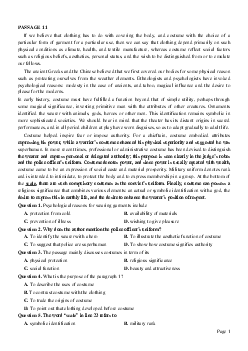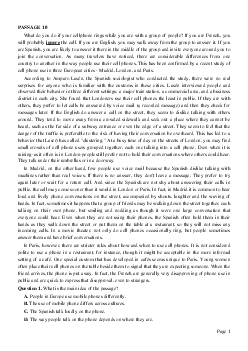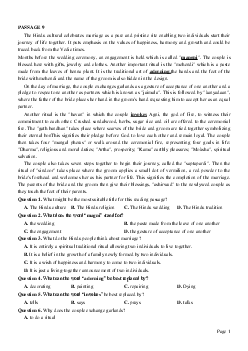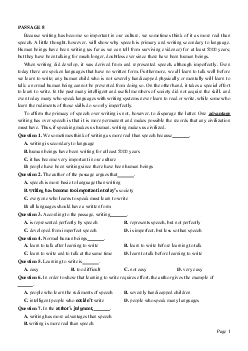

Preview text:
PASSAGE 32
Reading the news these days is often a depressing and anxiety inducing task. Mass shooting, pipe bombs,
assassinations, and – over it all – climate change haunt the discussion. The sources of these modern
human malignancies are generally the same: male leaders who want to maintain economic, political, and
religious power no matter the cost.
Cognitive scientists know that the female brain is different from the male. Women are less likely to
commit mass murder, less inclined to start a war, more likely to be in touch with and express their
emotions, and more interested in nuance, rather than decisiveness.
History shows that Egyptians knew than women ruled differently from men. And so they used them to
protect the patriarchy, to act as stopgaps, placeholders, until the next man could fill the top spot on the
social pyramid. But no matter how much power they held, even though many of them were called nothing
less than King, these formidable women of ancient Egypt were not able to transcend the patriarchal
agenda and change the system itself. When their reigns ended, the masculine Egyptian power structure remained intact.
These queens call out from the past, challenging us to place women into political power, not as
representatives of a patriarchal dynasty, but as women who serve their own, different agendas of social
connection and emotional cohesion, instead of aping the aggression of the fathers, brothers, and sons.
Question 1. What is the passage mainly about?
A. an uncertain world B. Egyptian queens C. female leading D. gender differences
Question 2. The following sentence would best be placed at the end of which paragraph?
It begs the question: Might women rule differently from men? A. Paragraph 1 B. paragraph 2 C. Paragraph 3 D. Paragraph 4
Question 3. The word “inclined” in paragraph 2 is closest in meaning to . A. reluctant B. slow C. opposed D. willing
Question 4. The word “them” in paragraph 3 refers to . A. women B. men C. Egyptians D. emotions
Question 5. Which of the following is NOT true about the Egyptian female leaders?
A. They held the positions which were equal to male leaders
B. They had real power when they were leaders.
C. They could change the Egyptian system.
D. They were sometimes more favorable than male ones Page 1 ĐÁP ÁN 1-C 2-A 3-D 4-A 5-B
LỜI GIẢI CHI TIẾT Question 1: C Ý chính của bài là gì?
A. một thế giới bất định B. Nữ hoàng Ai Cập C. lãnh đạo nữ D. khác biệt giới tính Question 2: A
Câu sau đây được đặt phù hợp nhất ở cuối đoạn nào?
Nó đặt ra câu hỏi: Phụ nữ có thể cai trị khác với đàn ông không? A. Đoạn 1 B. đoạn 2 C. Đoạn 3 D. Đoạn 4 Question 3: D
Từ ngữ “ inclined ’’trong đoạn 2 có nghĩa gần nhất với . A. miễn cưỡng B. chậm C. phản đối D. sẵn sàng
DẪN CHỨNG: Women are less likely to commit mass murder, less inclined to start a war, more likely
to be in touch with and express their emotions, and more interested in nuance, rather than decisiveness.
DỊCH: Phụ nữ ít có khả năng phạm tội giết người hàng loạt, ít có khuynh hướng bắt đầu chiến tranh, có
nhiều khả năng tiếp xúc và thể hiện cảm xúc của họ, và quan tâm nhiều hơn đến sắc thái, hơn là quyết đoán. Question 4: A
Từ “them” có nghĩa là họ trong đoạn 3 nói đến . A. phụ nữ B. đàn ông C. Ai Cập D. cảm xúc
DẪN CHỨNG: History shows that Egyptians knew than women ruled differently from men. And so they
used them to protect the patriarchy, to act as stopgaps, placeholders, until the next man could fill the top spot on the social pyramid.
DỊCH: Lịch sử cho thấy người Ai Cập biết hơn phụ nữ cai trị khác với đàn ông. Và vì vậy, người Ai Cập
đã sử dụng phụ nữ để bảo vệ chế độ phụ hệ, đóng vai trò là điểm dừng, giữ chỗ, cho đến khi người đàn
ông tiếp theo có thể lấp đầy vị trí hàng đầu trên kim tự tháp xã hội. Question 5: B
Điều nào sau đây KHÔNG đúng về các nhà lãnh đạo nữ Ai Cập?
A. Họ giữ các vị trí ngang bằng với các nhà lãnh đạo nam
B. Họ có quyền lực thực sự khi họ là nhà lãnh đạo.
C. Họ có thể thay đổi hệ thống Ai Cập.
D. Họ đôi khi thuận lợi hơn nam giới Page 2




